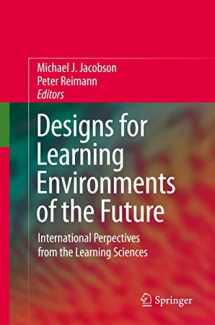
Designs for Learning Environments of the Future
ISBN-13:
9780387882789
ISBN-10:
0387882782
Edition:
2010
Author:
Jacobson
Publication date:
2010
Publisher:
Springer
Format:
Hardcover
304 pages
Category:
Education Theory
,
Computers & Technology
,
Schools & Teaching
FREE US shipping
Book details
ISBN-13:
9780387882789
ISBN-10:
0387882782
Edition:
2010
Author:
Jacobson
Publication date:
2010
Publisher:
Springer
Format:
Hardcover
304 pages
Category:
Education Theory
,
Computers & Technology
,
Schools & Teaching
Summary
Designs for Learning Environments of the Future (ISBN-13: 9780387882789 and ISBN-10: 0387882782), written by authors
Jacobson, was published by Springer in 2010.
With an overall rating of 3.7 stars, it's a notable title among other
Education Theory
(Computers & Technology, Schools & Teaching) books. You can easily purchase or rent Designs for Learning Environments of the Future (Hardcover) from BooksRun,
along with many other new and used
Education Theory
books
and textbooks.
And, if you're looking to sell your copy, our current buyback offer is $0.3.
Description
Few things are as certain as societal changes―and the pressing need for educators to prepare students with the knowledge and ways of thinking necessary for the challenges in a changing world. In the forward-thinking pages of Designs for Learning Environments of the Future, international teams of researchers present emerging developments and findings in learning sciences and technologies at the infrastructure, curricular, and classroom levels.Focusing on ideas about designing innovative environments for learning in areas such as biology, engineering, genetics, mathematics, and computer science, the book surveys a range of learning technologies being explored around the world―a spectrum as diverse as digital media, computer modeling, and 3D virtual worlds―and addresses challenges arising from their design and use. The editors’ holistic perspective frames these innovations as not only discrete technologies but as flexible learning environments that foster student engagement, participation, and collaboration. Contributors describe possibilities for teaching and learning in these and other cutting-edge areas: Working with hypermodels and model-based reasoning Using visual representations in teaching abstract concepts Designing strategies for learning in virtual worlds Supporting net-based collaborative teams Integrating innovative learning technologies into schools Developing personal learning communities Designs for Learning Environments of the Future will enhance the work of a wide range of professionals, including researchers and graduate students in the learning and cognitive sciences, and educators in the physical and social sciences.


We would LOVE it if you could help us and other readers by reviewing the book
Book review

Congratulations! We have received your book review.
{user}
{createdAt}
by {truncated_author}


